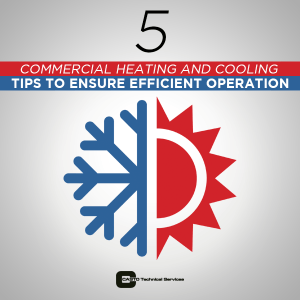 HVAC systems consume a large part of the energy used in a commercial business. On average, 15% of the energy used in commercial buildings goes to space cooling alone. In addition to the enormous amount of energy required to run HVAC systems, the U.S. Department of Energy estimates that 30% of this power is wasted in a commercial building. Wasted HVAC energy significantly increases operational costs for a commercial building, while also crippling sustainability. So how can commercial buildings cut back on this wasted energy and ensure that their HVAC systems are running as efficiently as possible? There are many simple steps that can aid in this effort, and more complex system upgrades that offer significant ROI in the long run. Take a look at our list of some of the best tips to ensure efficiency in commercial heating and cooling:
HVAC systems consume a large part of the energy used in a commercial business. On average, 15% of the energy used in commercial buildings goes to space cooling alone. In addition to the enormous amount of energy required to run HVAC systems, the U.S. Department of Energy estimates that 30% of this power is wasted in a commercial building. Wasted HVAC energy significantly increases operational costs for a commercial building, while also crippling sustainability. So how can commercial buildings cut back on this wasted energy and ensure that their HVAC systems are running as efficiently as possible? There are many simple steps that can aid in this effort, and more complex system upgrades that offer significant ROI in the long run. Take a look at our list of some of the best tips to ensure efficiency in commercial heating and cooling:
1. Verify proper operation of equipment including air dampers, air-side economizers, and heating/cooling valves. Dampers should be opening and closing fully. If the current system is using an air-side economizer, damper position and outside air flow rates can be used to determine if the economizer is functioning properly. Heating and cooling valves that are malfunctioning can cause unnecessary simultaneous heating and cooling. All of this equipment should be checked by an HVAC professional to ensure proper operation and maximize efficiency.
2. Use programmable thermostats. Programmable thermostats are a very simple way to save money on commercial heating and cooling. For example, in the summer, the temperature in a commercial building can be set cooler during the work day, and then allowed to rise a little higher overnight when the building is not in use. Of course, the opposite applies in the winter. This simple step can save hundreds of dollars a year in heating and cooling energy costs. Programmable thermostats are available in different models to accommodate different business schedules–7 day models are ideal for businesses with varying daily schedules while a 5+2 day model is ideal for a business operating a 5-day work week with no use on the weekends.
3. Schedule regular quality HVAC maintenance. In addition to the occasional “tune-up”, commercial HVAC systems benefit from regular maintenance as well. Regular maintenance can catch any issues the system may be having due to aging, faulty, or substandard equipment. If the system is only checked periodically, a business could end up running their HVAC systems for months at a time with faulty equipment, resulting in quite a lot of waste. Regular maintenance by a qualified HVAC technician with in-depth knowledge can reduce costs by 40%.
4. Eliminate duct leakage with proper sealing. Properly sealing air ducts can improve HVAC efficiency by at least 20%. Ducts should be inspected for leakage, especially in unprotected areas of the building (underneath the building). Leaking ducts can be sealed with mastic, foil-tape, or blown-in sealant. Wrapping the ducts in insulation is an additional step to improve sealing.
5. Investigate upgrades. If the building is old, there is a good chance that some components (or all) of the HVAC system is on its last legs. Air conditioners and heat pumps more than ten years old should be replaced with energy-star products. Furnaces or boilers more than 15 years old should also be replaced. Energy-star products can reduce energy costs by 20%, while also improving sustainability. Existing packaged rooftops can be retrofitted with demand controlled ventilation (bringing in ventilation air only when necessary) to improve performance.
Improving heating and cooling system performance in commercial buildings saves money and improves sustainability. It is important to work with a qualified HVAC technician to ensure proper repairs, upgrades, and system maintenance. Qualified HVAC technicians can spot problems with equipment immediately and save commercial buildings the headache of excessive wasted energy. Feel free to contact us today to learn more about improving your commercial heating and cooling systems.
